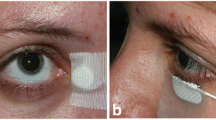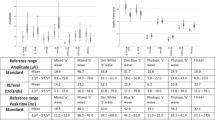Abstract
Background
The reproducibility of an individual’s full-field ERG between centres has not previously been investigated.
Methods
ERGs were recorded using both silver thread and skin electrodes from the same two normal adult subjects at 15 UK centres using routine, local protocols and a highly standardised, ‘ISCEV-specified’ protocol matching the values specified in the ISCEV standard; where the ISCEV standard allows options, a single value was chosen.
Results
Inter-ocular differences were small, and amplitudes were smaller for skin than silver thread electrodes. No centre produced outlying data points, and ERGs across all 15 centres were remarkably similar. Amplitude variability was less for local protocols (using LED flashes) than for the ISCEV-specified protocol using xenon flashes (22 vs. 24 %, p = 0.01), but peak time variability was less for the ISCEV-specified protocol (6.1 vs. 7.4 %, p = 0.001). Only the DA 0.01 ERG correlated with photometric variability. The bifidity of the DA 3 a-wave doubled its peak time variability compared with the DA 10 a-wave.
Conclusions
Inter-centre amplitude variability was typically within clinically significant thresholds, suggesting that inter-centre variability with suitable standardisation may not add more to total variability than inter-subject variability. Variability improvements gained by the tighter specifications of the ISCEV-specified protocol were possibly more than lost due to imprecisions of xenon flashtubes. Peak time variability was far lower than amplitude variability, corresponding with acceptable variability of biochemical assays. These results represent a vindication of the existence of an ERG standard and suggest that further standardisation would lend itself to greater reproducibility of ERGs worldwide.









Similar content being viewed by others
Notes
Photopic specification assumed hereafter for photometric units.
References
Marmor MF, Arden GB, Nilsson SEG et al (1989) Standard for clinical electroretinography: international standardization committee. Arch Ophthalmol 107:816
Marmor MF, Fulton AB, Holder GE et al (2009) ISCEV Standard for full-field clinical electroretinography (2008 update). Doc Ophthalmol 118:69–77. doi:10.1007/s10633-008-9155-4
Hund E, Massart DL, Smeyers-Verbeke J (2000) Inter-laboratory studies in analytical chemistry. Anal Chim Acta 423:145–165
International Standardization Organisation (1994) ISO 5725:1994(en) Accuracy (trueness and precision) of measurement methods and results. Switzerland, Geneva
Bergmann H, Dobrozemsky G, Minear G et al (2005) An inter-laboratory comparison study of image quality of PET scanners using the NEMA NU 2-2001 procedure for assessment of image quality. Phys Med Biol 50:2193–2207. doi:10.1088/0031-9155/50/10/001
Walker L, Curry M, Nayak A et al (2013) A framework for the analysis of phantom data in multicenter diffusion tensor imaging studies. Hum Brain Mapp 34:2439–2454. doi:10.1002/hbm.22081
Aunon JI, Cantor FK (1977) VEP and AEP variability: interlaboratory vs. intralaboratory and intersession vs. intrasession variability. Electroencephalogr Clin Neurophysiol 42:705–708
Harrison WW, Bearse MA, Ng JS et al (2009) Reproducibility of the mfERG between instruments. Doc Ophthalmol 119:67–78. doi:10.1007/s10633-009-9171-z
Hamilton R, Al Abdlseaed A, Healey J et al (2013) Variability of flashes and background luminances of clinical electroretinography stimuli across 14 UK centres. J Mod Optic 60:1209–1216. doi:10.1080/09500340.2013.824124
Bland JM, Altman DG (1995) Multiple significance tests: the Bonferroni method. Brit Med J 310:170. doi:10.1136/bmj.310.6973.170
Bland JM, Altman DG (1996) Statistics notes: measurement error proportional to the mean. Br Med J 313:106
Horwitz W (1982) Evaluation of analytical methods used for regulation of foods and drugs. Anal Chem 54:67A–76A. doi:10.1021/ac00238a002
Healey J, Al Abdlseaed A, Nevea M et al (2012) Variability of amplifier characteristics across 15 UK clinics. ISCEV 50th Symposium, Valencia, Spain. Doc Ophthalmol 121(1S):37
Rotenstreich Y, Fishman GA, Anderson RJ, Birch DG (2003) Interocular amplitude differences of the full field electroretinogram in normal subjects. Brit J Ophthalmol 87:1268–1271. doi:10.1136/bjo.87.10.1268
Birch D, Anderson J (1992) Standardized full-field electroretinography—normal values and their variation with age. Arch Ophthalmol 110:1571–1576
Jacobi PC, Miliczek K-D, Zrenner E (1993) Experiences with the international standard for clinical electroretinography: normative values for clinical practice, interindividual and intraindividual variations and possible extensions. Doc Ophthalmol 85:95–114. doi:10.1007/BF01371126
Chambers W (2005) Regulatory perspectives. Special session on drug development & clinical trials ISCEV XLIII Symposium, Glasgow, UK. ISCEV, ISBN 0-9527391-2-7:89
Birch DG, Anderson JL, Fish GE (1999) Yearly rates of rod and cone functional loss in retinitis pigmentosa and cone-rod dystrophy. Ophthalmology 106:258–268. doi:10.1016/S0161-6420(99)90064-7
Grover S, Fishman GA, Birch DG et al (2003) Variability of full-field electroretinogram responses in subjects without diffuse photoreceptor cell disease. Ophthalmology 110:1159–1163. doi:10.1016/S0161-6420(03)00253-7
Fishman GA, Chappelow AV, Anderson RJ, et al. (2005) Short-term inter-visit variability of erg amplitudes in normal subjects and patients with retinitis pigmentosa. Retina (Philadelphia, Pa) 25:1014–1021
Hill P, Uldall A, Wilding P (1996) Fundamentals for external quality assessment (EQA). Guidelines on improving analytical quality by establishing and managing EQA schemes. Examples from basic clinical chemistry using limited resources. IFCC, Milano, Italy
Coupland SG, Janaky M (1989) ERG electrode in pedriatic patients: comparison of DTL fiber, PVA-gel, and non-corneal skin electrodes. Doc Ophthalmol 71:427–433. doi:10.1007/BF00152771
Esakowitz L, Kriss A, Shawkat F (1993) A comparison of flash electroretinograms recorded from Burian Allen, Jet, C-Glide, Gold Foil, Dtl and skin electrodes. Eye 7:169–171
Mortlock KE, Binns AM, Aldebasi YH, North RV (2010) Inter-subject, inter-ocular and inter-session repeatability of the photopic negative response of the electroretinogram recorded using DTL and skin electrodes. Doc Ophthalmol 121:123–134. doi:10.1007/s10633-010-9239-9
Al Abdlseaed A, McTaggart Y, Ramage T et al (2010) Light- and dark-adapted electroretinograms (ERGs) and ocular pigmentation: comparison of brown- and blue-eyed cohorts. Doc Ophthalmol 121:135–146. doi:10.1007/s10633-010-9240-3
Hogg C, Shaheen S, Hamburg S et al (2014) Comparison of dark-adapted ERGs to standard and bright flashes in controls and patients. ISCEV 51st Symposium, Chongqing, China. Doc Ophthalmol 127(1S):12
Feinberg M (1995) Basics of interlaboratory studies: the trends in the new ISO 5725 standard edition. TrAC Trend Anal Chem 14:450–457
Vander Heyden Y, Smeyers-Verbeke J (2007) Set-up and evaluation of interlaboratory studies. J Chromatogr A 1158:158–167. doi:10.1016/j.chroma.2007.02.053
Acknowledgments
We gratefully acknowledge the following: Mrs. Mary Broadberry, Dr. Paul Spry, Professor Daphne McCulloch, Dr. Richard Hagan, Dr. Neil Parry, Mr. Chris Hogg, Mrs. Karen Bradshaw, Mrs. Beverley Holland, Dr. Charles Cottrial and Dr. Gillian Ruddock; Mr Donnie Smith, Medical Device Section, Department of Clinical Physics and Bioengineering, NHS Greater Glasgow & Clyde, UK, for design and manufacture of the amplifier calibrator. These data were presented at ISCEV 2012 and BriSCEV 2012.
Conflict of interest
The authors accepted a donation of the silver thread electrodes used from Professor Anthony Fisher, Department of Clinical Engineering, Royal Broadgreen Liverpool Hospitals. All authors are, or have been, members of ISCEV, which has non-financial interest in the ERG standard discussed in this manuscript and which awarded a small grant for laboratory visits to part-fund the project. All authors certify that they have no other affiliation with or involvement in any organisation or entity with any financial or non-financial interest in the subject matter or materials discussed in this manuscript.
Author information
Authors and Affiliations
Corresponding author
Rights and permissions
About this article
Cite this article
Hamilton, R., Al Abdlseaed, A., Healey, J. et al. Multi-centre variability of ISCEV standard ERGs in two normal adults. Doc Ophthalmol 130, 83–101 (2015). https://doi.org/10.1007/s10633-014-9471-9
Received:
Accepted:
Published:
Issue Date:
DOI: https://doi.org/10.1007/s10633-014-9471-9




